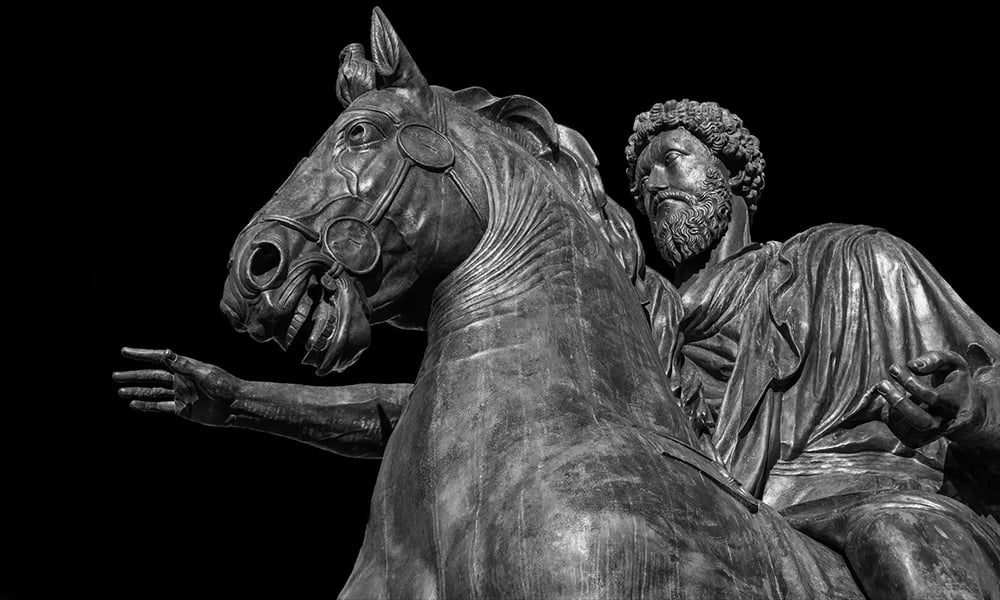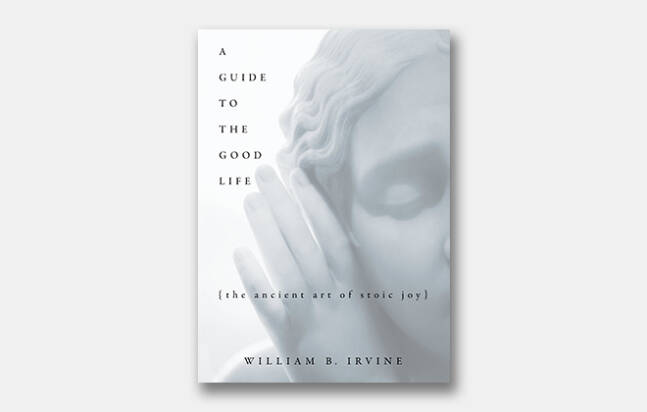Can people train themselves to be happier? Can they hack the human psyche for greater fortitude, fulfillment, and joy? According to the teachings of Stoicism, one of the richest intellectual threads of the classical world, yes.
Stoicism is often misunderstood in popular culture. Tony Soprano, during one of his many colorful rants to his shrink Dr. Melfi, nailed the widespread but incorrect take on the ancient philosophy: “Whatever happened to men like Gary Cooper? The strong, silent type. He wasn’t in touch with his feelings. He just did what he had to do.” Likewise, folks often described my grandfather, a World War II veteran who turned to the bottle to cope with PTSD, as a stoical man.
But the Stoic sages, men like Marcus Aurelius and Seneca, were not a bunch of emotionally constipated grumps who advocated spiritual numbness. On the contrary, they marveled at the sublime mystery of being alive and sought to relish the world’s beauty as deeply as possible. Far from shunning life’s wondrous rollercoaster, genuine Stoicism offers thoughtful advice for making the most of our earthly tenure and leading a life marked by real joy as well as dignity in the face of suffering.
Scholars credit Zeno of Citium, a Greek philosopher born 350 BCE in modern-day Cyprus, as the father of Stoicism. Zeno had a penchant for lecturing al fresco in the Athenian Forum, standing atop a colonnade—or in Greek, a stoa, hence the name given to his followers. Classical Greece had mercantile ties to India, and Buddhist philosophy has a lot of similarities with Stoicism. After the Roman conquest of Greece circa 150 BCE, the Stoic torch passed from Attica to the Italian Peninsula.
While other Hellenic philosophers like Plato and Aristotle speculated on ethereal questions—Is there life after death? Is the universe eternal? Why does anything exist at all?—the Stoics, generally speaking, didn’t care about such unanswerable mysteries. Instead, over a dialogue spanning centuries, they grappled with a singular question: “What makes a good life?” Their responses were multifaceted, but the Stoic masters, both in Greece or Rome, agreed on the importance of cultivating eudaimonia, meaning an inner peace that could weather all vicissitudes.
Their counsel for a good life starts with discipline, reflection, and an element of strategic planning. Equally important is to not squander life by chasing misguided goals, or “misliving.” These Stoic pearls of wisdom will help you mitigate the risk of misliving and to cultivate greater joy, courage, and mindfulness for the remainder of your precious days.
Cultivate Gratitude
Modern people have more marvels, luxuries, and comforts at their disposal than even the most magnificent kings and sultans of the past. But it can still be easy to base your happiness level on how you stack up to peers. Put simply: It’s easy to feel satisfied while one-upping those around us. And even then there’s the issue of seeking ever more elite peers to compare ourselves against rather than stopping to recognize a personal accomplishment.
The Stoics recognized this psychological trap, and as an escape route they recommended training the mind to want what’s already had. The top of the mountain forever recedes and higher levels of success, pleasure, or accomplishment increase ad infinitum. Instead of exhausting yourself in the rat race, learn to deepen your gratitude for the good things already at hand.
To this end, the Stoics advocated a simple yet powerful technique called negative visualization. The first step entails taking stock of the good things we already have—both tangibles like home, hearth, and friends, and intangibles like health and safety. Then imagine that such blessings were suddenly ripped away. For example, after acknowledging the gift of health, visualize the nightmare of a terminal diagnosis or a debilitating injury. Feel that imagined despair for a second, then simply remind yourself that you still have your health—at least for now. This same method can be applied to foster gratitude for all things.
The mantra “It could be worse” might seem like cold comfort, but negative visualization really does take some of the sting out of life’s disappointments. The teachings of Stoicism, like those of Buddhism, underscore the truth that all is transient. As an added benefit, negative visualization prepares us for the inevitable real losses of the things we cherish.
Seek Self-respect, Not Fame
Jim Carey famously quipped, “I wish everybody would become famous…so they would see that it’s not the answer.” Marcus Aurelius, the emperor who shunned celebrity as the “clacking of tongues,” agreed with the contemplative comedian. In the age of social media, when cravings for public validation are at epidemic levels, the Stoic warning about fame’s pitfalls has never been timelier.
So how exactly is fame detrimental? Chasing fame ultimately enslaves us to the whims and expectations of an anonymous crowd. When our happiness depends on public applause, we set ourselves up for sorrow when we inevitably fade into irrelevance. Plus, obsessing over public opinion distracts us from the miracle of the present moment.
Strive to master your field not for celebrity, but because meaningful toil is fulfilling in and of itself. Whether you butter your bread as an artist, an entrepreneur, or a skilled laborer, striving for excellence precipitates lasting self-respect. Yes, some people do become famous as a consequence of exceptional work, but they would be wise to ignore the accompanying celebrity as best they can. Whereas fame equates to a psychological prison, the self-respect gained through striving for excellence and mastery is an essential ingredient of eudemonia.
And if you’re still unconvinced fame is overrated, Marcus Aurelius reminds us that even those standing at the apex of fame dwindle from memory in the long run: “The people who remember [the famous] will soon die too. And those after them in turn. Until their memory, passed from one to another like a candle flame, gutters and goes out.” (Ironically, it should be noted, this takes longer for some than others, as the memory of Marcus Aurelius has not dwindled.)
Embrace Aging
While modern society deems growing old a catastrophe, Seneca, one of the most seminal Roman Stoics, argued that our best years arrive after the blush of youth fades: “Let us cherish and love old age; for it is full of pleasure if one knows how to use it. Fruits are most welcome when almost over; youth is most charming at its close; the last drink delights the most.”
Why could the waning of physical prowess facilitate happiness? Eudaimonia is more elusive for the young because of relentless grasping for things like status, sex, and the fulfillment of ambitions. As the fires of youth cool, we stop reaching for more and learn to rest on our laurels. When the longings for name and fame subside, we can live in the present moment more completely.
Keep Death in Mind
For the Stoics, death was the ultimate test of resolve and character. All of life’s suffering and setbacks were mere preparation for facing death. But the final curtain was no horror from which to cower if life was lived properly. The Stoics would have agreed with Leonardo Da Vinci that “just as a well-spent day brings sweet sleep, so a life well used brings sweet death.” Those who lived wisely enter the eternal night in peace, while those who squandered their lives recoil in terror.
Similar to negative visualization, the Stoics recommended imagining death regularly. This practice of memento mori not only lessens the horror of death but compels us to savor our remaining time left. Keeping the Grim Reaper in the back of our minds makes us less willing to let our days slip by meaninglessly.
Stoicism Tools To Live a More Fulfilling Life
A Guide to the Good Life, by William B. Irvine
If you resonate with Stoicism, you will likely revisit Dr. William Irvine’s brief but powerful introductory primer over and over again. Available in book form and Amazon Audible, this 8.5-hour audiobook takes listeners on a vivid tour of Stoic history from Greece to Rome and expounds upon the fundamental tenets of the Stoic mind. Dr. Irvine describes in colorful detail the captivating, diverse lives of Marcus Aurelius, an emperor; Epictetus, an enslaved person; Seneca, a martyr; and other sages who created this rich and multifaceted philosophy. Most importantly, Dr. Irvine convincingly explains how Stoic wisdom can succor those in the 21st century who are suffering from sensory overload and burgeoning depression.
Meditations, Marcus Aurelius
Military mastermind, wise ruler, and philosopher-poet, Marcus Aurelius was one of the most magnetic personalities in history. Meditations, a series of pithy observations and aphorisms Aurelius wrote while on a military campaign in Germania, has long been enshrined in the canon of Western literature. In succinct and deeply memorable prose, Aurelius offers advice and musings on topics ranging from friendship and love to facing hardships and cultivating wisdom. Like Ecclesiastses or Proverbs, countless souls cherish Meditations as a lifelong literary companion that’s a manual of wise counsel for any of life’s momentous occasions.
The Stoic App
Available on IOS and Android, the Stoic improves mental health through time-honored Stoic wisdom combined with high-tech data analytics and the insights of modern psychology. Users record how they feel each day, and the app guides them through breathing exercises, reflective journaling, and more. In one of its most useful features, Stoic users can customize a morning routine to fortify themselves against the day’s challenges and an evening routine to facilitate relaxation and quality rest. An app for our pluralistic society, Stoic also proffers daily maxims from Buddhism, Taoism, and Catholicism.
Learn More






